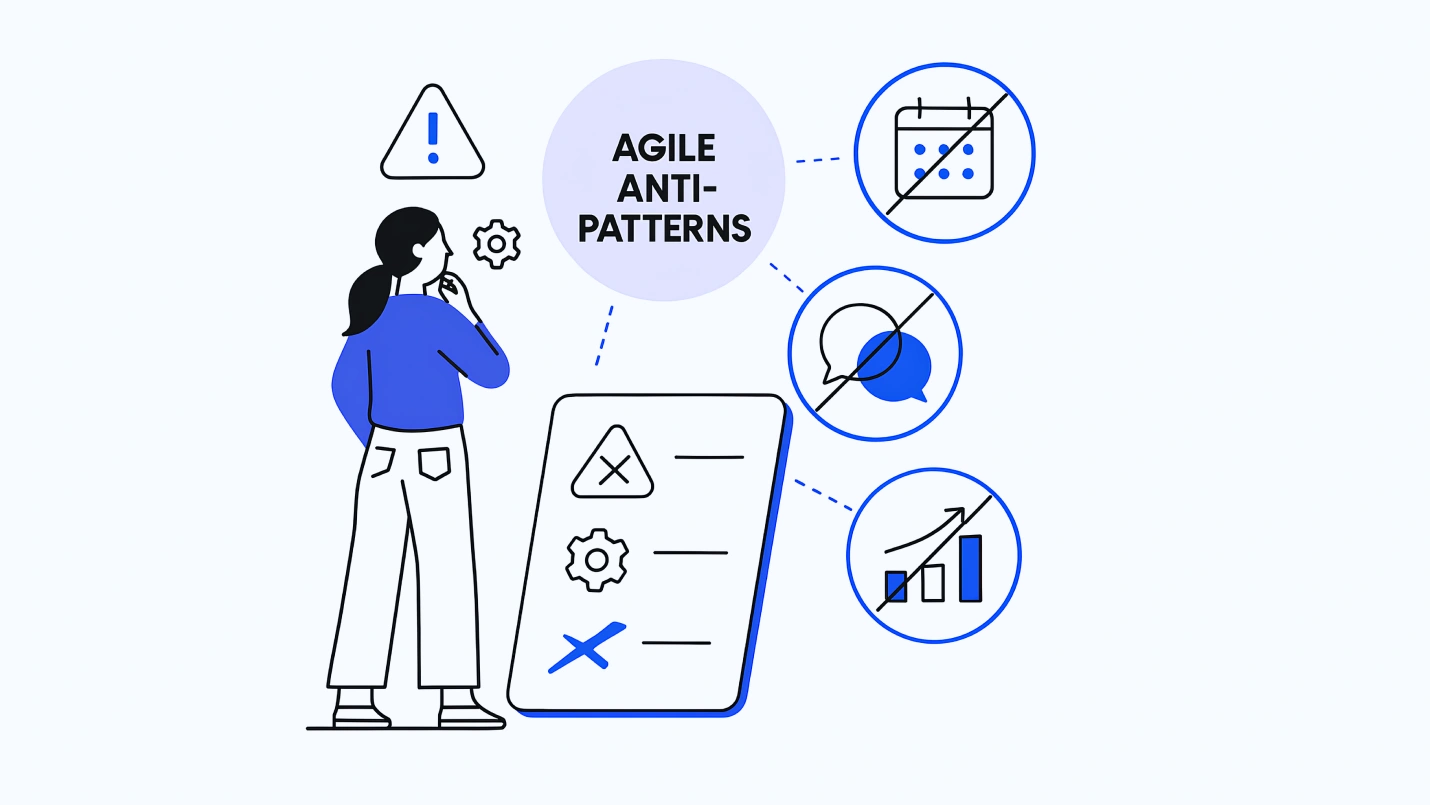The Agile Development methodology has become a predominant part of the software development processes today. As organizations are still wrapping their heads around this right process to software development, the impediments on the way are hampering the journey to building the product right. These impediments are called agile anti-patterns that are common problems in an Agile workflow, which, in turn, can lead to technical debts.
According to Net Solution’s Agile Product Development report, 57.8% of organizations understand Agile “somewhat,” while 4.4% do not understand Agile at all.
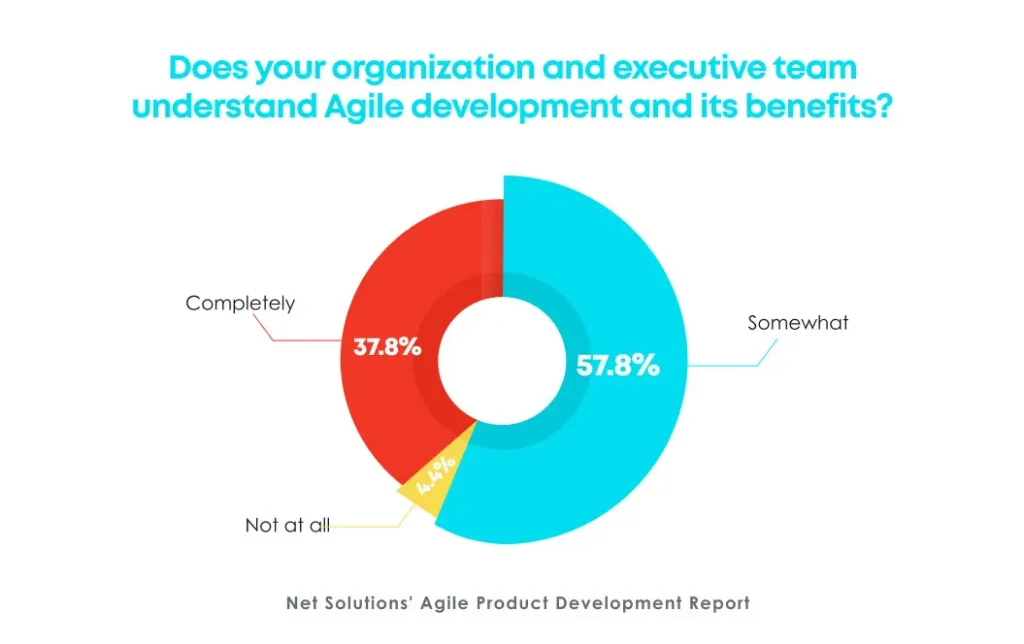
These anti-patterns may appear to offer a solution to a problem at hand but have several underlying inconsistencies. And as remote work is changing the work dynamics, these anti-patterns are only known to be escalating.
You can blame the golden hammer bias for the existing anti-patterns, i.e., either you over-rely on the traditional methodologies such as the waterfall, or you think you understand Agile development solutions to the core. None of the two will help in fostering productivity. So, what can help is — understanding the anti-patterns in your project management process and looking for viable solutions to get rid of it.
Here is a guide on scrum anti-patterns that introduces the top five agile anti-patternsf to be aware of, along with corresponding recommendations on how to eliminate them.

We respect your privacy. Your information is safe.
What are Anti-Patterns in Agile?
Anti-patterns in agile or scrum anti-patterns are (bad) practices that you follow to improve the process. Still, they do the opposite by hampering your efforts and slowing your progress towards achieving Agile goals.
It is a disguised form of Agile Development methodology that poses to be a solution but creates negative consequences that you might realize later. That is why retrospectives need to be taken seriously so that the development team can identify potential problems with the existing process (based on past mistakes) and can introduce improvements.
What can go wrong will go wrong — unless you identify potential problems earlier. — Mike Cohn, Mountain Goat Software
Top Five Agile Anti-Patterns in Software Development Process
Here are the top five agile anti-patterns that can de-accelerate time to market:
1. Miscommunication
The first value of the Agile Manifesto recommends preferring individuals and interactions over processes and tools. Yet, organizations fail to implement this very basic rule when creating software and instead are seen working in a somewhat mushroom management setting. In fact, the daily stand-ups that the scrum development teams conduct to understand the progress of the teams is an agile antipattern too.
According to Net Solutions’ Agile Product Development Report, 22.8% percent of organizations feel that communication has been a challenge to cope with for their remote teams.
Solution:
a. Mob Programming
Mob programming is a practice where the entire agile team works on the same thing, at the same time, and on the same system. This is a great practice to follow where the UX designers, architects, developers, and testers can communicate and collaborate to understand each other’s processes and solve a problem at hand (collectively). Be it software design, development, or anything else related to the product.
b. Rely on Collaboration Tools
Remote work or no remote work, collaboration tools can undoubtedly lend a hand at filling the communication gap. You can conduct brainstorming sessions and plan around a remote stack that suits your business needs. Ensure you do not invest much in boat anchors (a piece of software or hardware that is not useful) as it will add up to the costs.
Here is a list of tools that we suggest:
| Short-term Communication | Slack, Microsoft Teams, Skype | |
| Video Communication | Zoom, Google Meet, Loom | |
| Large-File Sharing | Google Drive, Dropbox | |
| Developer Tools | Jira, GitHub, Tuple | |
| Designer Collaboration Tools | InVision, Figma, Marvel | |
| Work Management Tools | ClickUp, Trello | |
| Data Management Tools | Airtable, Notion | |
| Virtual Collaboration | Freehand by InVision, Miro and Mural, Basecamp | |
c. Get Over Progress Status
Scrum meetings are generally about following up on the progress status, i.e., where are you on your way to completing tasks assigned to you in that particular sprint. They are considered long, flow breakers, and meaningless at times. But, that should not be the perspective around it! Daily stand-ups should be serving the purpose well. Here are some suggestions:
- Create separate channels such as on Slack that make conversations easy and intent-driven. Team members can directly communicate there and talk about their roadblocks and seek suggestions.
- Limit a large number of active participants in a scrum meeting or a scrum event. The general recommendation is around limiting the number of members to nine.
- Go beyond the traditional three questions, “what you did yesterday,” “what are you planning for today,” and “what roadblocks are you facing.” Ask questions that go beyond the norm and act as icebreakers in a scrum event.
2. Unclear Requirements and Expanding Scope Creep
The product owner is the bridge between the agile teams and the client and ensures that the requirements are communicated as it is, i.e., the ideas match with the final product. However, often the authenticity of the requirements goes amiss.
Be it the sprint planning meetings or the product backlog meetings, if the requirements are not clearly discussed — the MVP and the corresponding final product suffers. A non-details requirement can be perceived in many ways, and hence its feasibility can vary for different members.
According to Net Solution’s Agile Product Development Report, businesses reported around 10-30% of their products fail to meet customer needs.
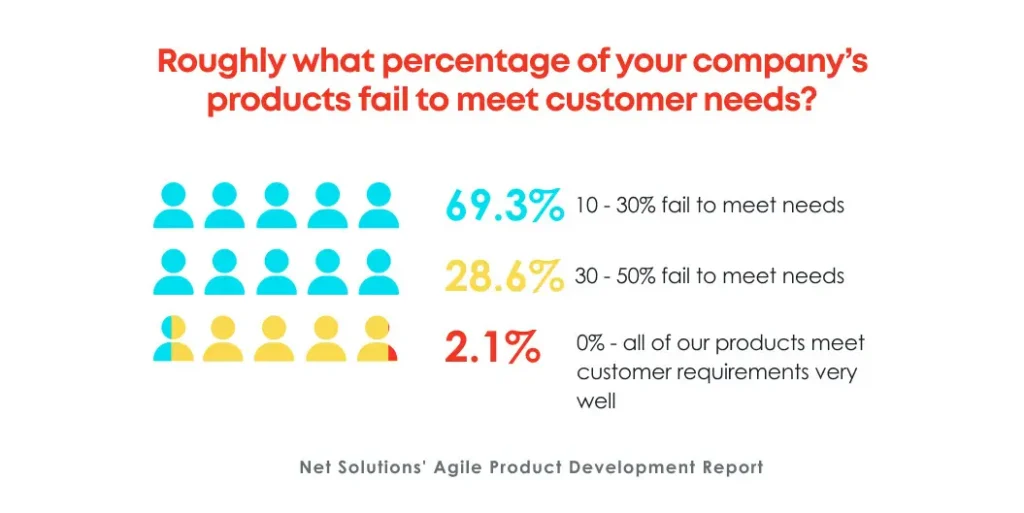
The negative consequences of it lead to a lot of rework, and thus piling up technical debts and delayed time to market.
Moreover, the expanding scope creep or the feature creep during the Agile process adds to the confusion, which further leads to requirement mismatch with the deliverables.
Solution:
- Document the requirements. Do not rely on verbal communication of the requirements alone.
Take the product backlog meetings seriously. Ensure all the three scrum roles attend these meetings so that no scope of confusion exists. - Use collaboration tools such as ClickUp or Trello to maintain transparency of tasks to complete in a particular sprint. This way, everyone can stay on the same page while knowing what they need to be doing.
- Communicate with the stakeholders to verify the documented requirements. Their go-ahead matters when finalizing the requirements.
3. Gold Plating or Scope Stretching
Gold plating or scope stretching is the act of extending the workload unnecessarily and working on something, which was not even required in the first place.
A lot many times, the agile team extends its responsibilities unnecessarily. In the process of overdoing it, they are seen diverting from the initially defined scope, thus leading to inconsistencies and delays with the deliverables — in turn, unhappy clients and customers.
In most cases, neither the product owner nor the scrum master is aware of the increasing (not needed) burden that the team adds to their shoulders. So, how do you avoid gold plating in the agile workflow?
Solution:
- Results should be mapped against the underlying requirements at the end of every sprint.
- There needs to be a constant communication channel between the product owner and the Agile Development team (UX designers + Agile Developers + Agile Testers).
- The development team should be strictly instructed to stick to the documented requirements. Nothing except the aforementioned requirements will be accepted. If they feel otherwise and feel it necessary to work on something out of the scope, they need to discuss it first with the concerned parties.
4. Ignorance of Sustainable Pace
More often, the development team moves ahead with the next user stories in the line before resolving the issues of the previous sprint. Talking of the right way to do it, the teams should thoroughly deliver the previous user story before moving ahead.
When the previous sprint user stories appear later in the consecutive sprint cycles, the agile team’s burden increases, resulting in burnouts and zero productivity.
Thus, the teams should not ignore the sustainable pace, i.e., making agile teams work at a pace they can manage without resulting in burnouts. If the teams overload themselves with the user stories of the past sprints and the current sprints, the sustainable pace will go amiss.
Solution:
- The Agile teams should not be working beyond 40 hours per week if a sustainable pace needs to be maintained.
- The scrum master should entirely take up the charge and should monitor how teams are working. Over commitments should not be promoted.
- Mike Cohn introduces an innovative way to address burnouts, which he refers to as 6 x 2 + 1 (“six times two plus one”). This implies that the teams can work in six, two-week sprint cycles to complete a user story at hand. The left one-week sprint should be freely allocated to the team, where they can either work on pending user story polishing and reworks or on self-development, where they can learn and upskill.
- Prefer creating “Spikes,” which are separately time-boxed sprints allocated to research a question or resolve a problem at hand.
5. Considering Discovery and Delivery as Separate Entities
Agile teams consider discovery, i.e., requirement finalization and delivery, i.e., submitting the requirements as separate tasks. This is an agile anti-pattern that needs to be eliminated when agile development is in question. Moreover, the scrum roles are seen creating Gantt charts (illustrates the project’s schedule) for Agile, which makes no sense.
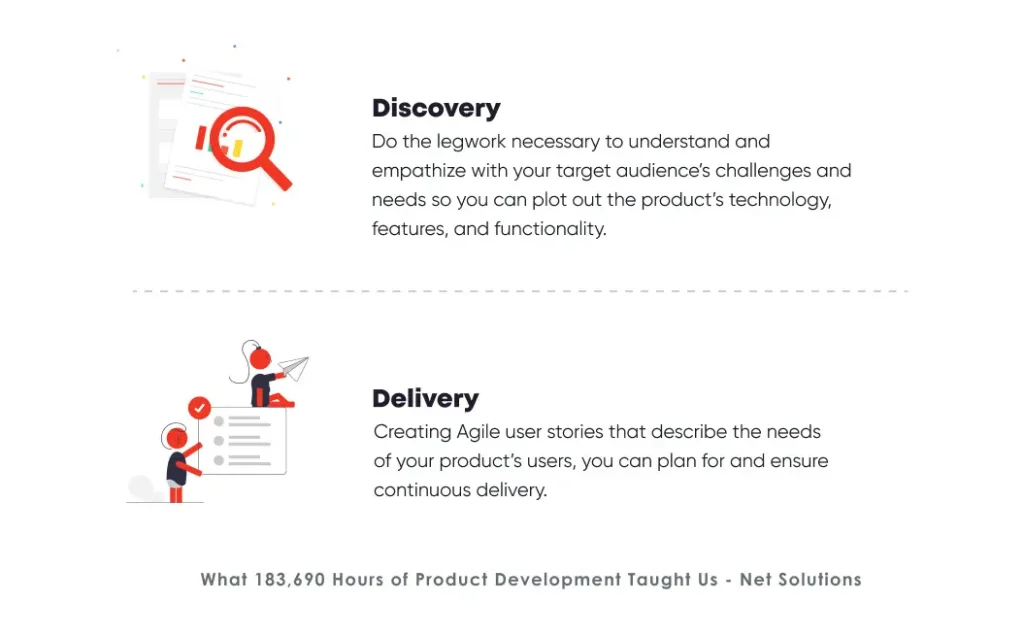
Agile is synonymous with iterative and incremental development, which, in turn, implies that discovery should never be finalized beforehand, as requirements (are ever-evolving) can change at any point in time during development.
Quoting in the right words from our eBook on “What 183,690 hours of product development taught us?”:
It would be best to showcase an agile mindset, similar to a spacecraft engineer who keeps making repairs while in space to ensure that the spacecraft keeps functioning. In simpler words, it implies doing core system replacement while continuing to deliver value.
Solution:
- Never fix what you are going to build beforehand. The discovery is an ongoing process that should be closely tangled with delivery.
- Launch your MVP. Wait for the feedback and continue with refinements of the existing features along with managing the new additions.
- Do not create Gantt charts for your agile projects, which are suitable where discovery is a one-time process. Though many will suggest you do so, Gantt charts defy the entire purpose of agile, which relates to unpredictability.
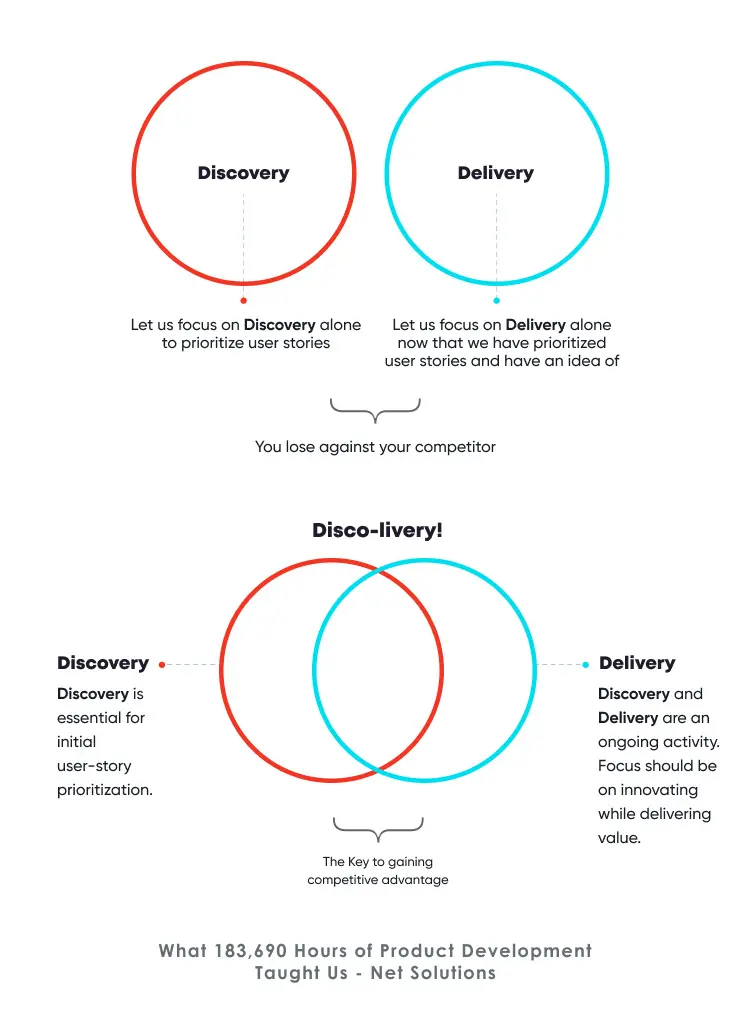
Conclusion
Software Development anti-patterns can occur at any stage of a process. These are recurring problems that businesses face during an agile project.
Anti-patterns cleverly disguise themselves for quick fixes for common issues but turn out to be inefficient in the final analysis.
Short-term thinking is the most significant factor responsible for anti-patterns. However, you can avoid these indistinguishable enemies by a few changes in your methodologies and building a long-term vision for the project’s success.

